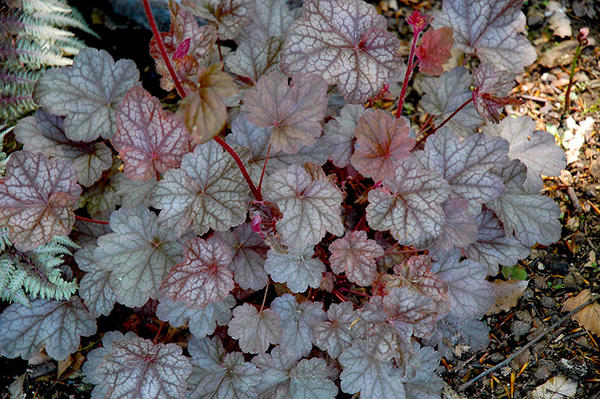
Increasingly, landscape designers use a heicher as the main decorative element of the garden. And all because this many-faced flower impresses with the beauty and diversity of its foliage. Large leaves on thick erect shoots are painted in a variety of colors, sometimes even get black shades with elegant white fringe along the edges. And it seems that openwork leaves can endlessly change their color, tirelessly impressing their viewer.
Content
- 1 The use of heichera in landscape design
- 2 Geicher combined with other colors
- 3 Choosing a landing place
- 4 Types of Heicher
- 4.1 Heichera blood red Heuchera sanguinea
- 4.2 Heichera American Heuchera americana
- 4.3 Heichera hairy Heuchera villosa
- 4.4 Heicher cylindrical Heuchera cilindrica
- 4.5 Heichera hybrid Heuchera hybrida
- 4.6 Heichera gooseberry leaf Heuchera grossulariifolia
- 4.7 Heichera small-flowered Heuchera micrantha
- 4.8 Caramel
- 4.9 Marmalade
- 4.10 Geicher Cherry Cola
- 4.11 Purple castle
- 4.12 Black bird
- 5 Conclusion
The use of heichera in landscape design
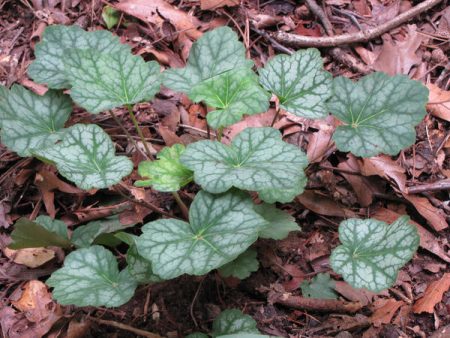
Geichera is a universal plant. With just a few young seedlings of this amazing flower in your arsenal, you can transform the garden plot beyond recognition. Decorators fell in love with compact stunted heichera bushes for beautiful foliage that changes color throughout the season and paniculate large inflorescences of soft pink and red shades.
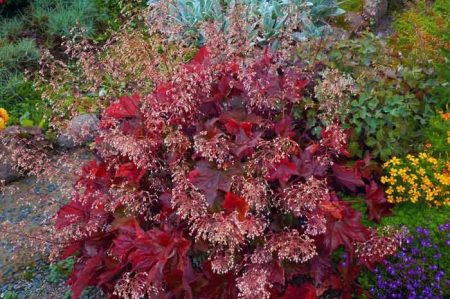
The genus Heuchera got its name in honor of the German physician, botanist Geicher (1677-1746).
Cultural value:
- heichera retains its decorative effect for a long time;
- variegated bushes create bright "colorful" spots on the monolithic background of the garden;
- the ability to choose "their" heichera due to the huge variety of varieties and species;
- the culture can be grown both in open ground and in containers and greenhouses;
- unpretentious plant, frost-resistant, can grow in the shade;
- it reproduces very simply;
- fits harmoniously into any floral arrangement, looks great as a tapeworm;
- not afraid of humidity, drought, so it can be planted near ponds, on hills, in rock gardens.
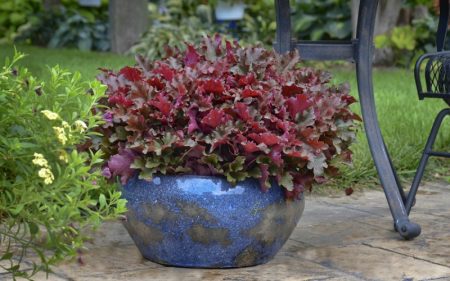
Modern tendencies in the “decoration” of the garden gravitate towards volumetric mixborders that are designed to keep the garden beautiful, but also to determine its style, consistent in color and texture. The summer resident, following the fashion, always painstakingly selects the elements of flora suitable for his site. And when there are certain doubts about many plants, then the heichera is precisely the element that will be appropriate in any composition, be it Provencal, rustic, Scandinavian or any other style. In landscape design, there are many ideas on her account.
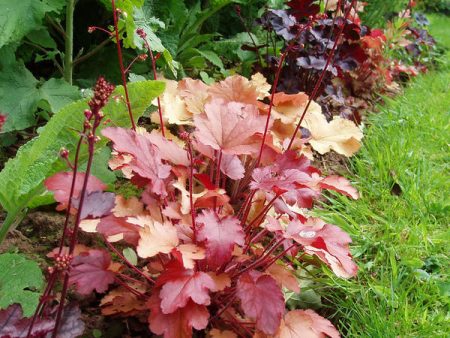
Ideas for decorating a garden using a heichera:
- Tapeworm landing. Geichers are most often used to decorate the "boring" voids of a summer cottage. As a tapeworm, variegated shrubs look very impressive. They can refresh even the most remote corner of the garden, as well as cover the imperfections of the area with their lush and dense crown. Throughout the year, the bush will retain its colorful appearance, changing the color of foliage from green to bronze, and from bronze to purple, etc.
- Multi-group flower arrangement. In large front gardens and flowerbeds usually place up to a dozen or more species of flower plants. All of them differ in texture, color, growth and flowering period. To balance the composition, a heicher is often used as a “midtone”. That is, it serves as a kind of smooth transition from one flower to another. And thanks to the continuous attractiveness of the bush, a heicher will decorate the flower garden during the off-season of other flowers.
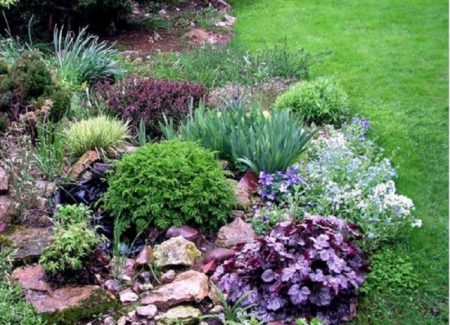
- Rock garden.Artificially created rocky garden like no other reflects the beauty of heichera, especially in combination with other flower plants. Openwork large foliage of various shades, coupled with long peduncles decorated with loose inflorescences, ideally combined with stones, creating a primitive look of a stone building.
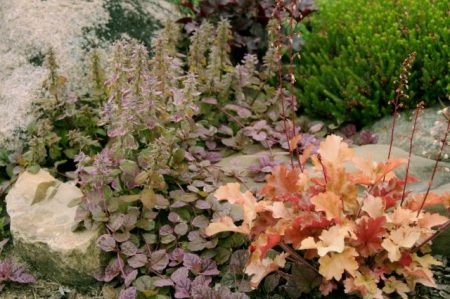
- Array Geicher can often be seen in the stands of large plants. In large-scale compositions, it occupies the bottom row, covering itself with long trunks and stems of tall crops.
- Parterre. Heicher looks great in a ceremonial flower garden among the flowers of the same stature as she is. It is located at the entrance to the park, square, summer cottage, at the porch. They choose a heicher for these purposes, primarily because of the ability to maintain a beautiful appearance throughout the year, and this is important for such flower beds - to create beauty at the entrance.
- Borders and paths. The heicher planted along the tracks looks spectacular and unusually stylish. Shrubs bordering the paths create a unique flavor with their lush texture, especially during the flowering period.
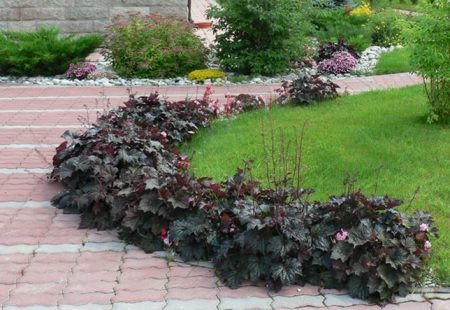
- Cache-pot and containers. Many varieties of heichera are suitable for growing in bulky pots and flowerpots, which decorate arbors, terraces, verandas or just arrange in the garden. Caring for such plants is not difficult, because all they need is regular watering and timely top dressing.
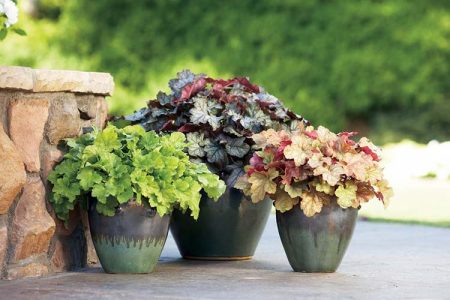
- In the design of coastal zones. Moisturizing geichers also plant along water backwaters, lakes, artificial reservoirs. Volumetric bushes, placed singly or in heaps, make the coastal zone fabulous, add exotic water to the reservoir and the area next to it.
A torn bouquet of heicher can be stored for about a month, exuding a pleasant honey aroma throughout the house.
Geichera is a very picky plant. It can grow well in the company of its own kind or coexist with other types of flowering plants, without oppressing them and without losing itself. Her leaves are able to change the appearance of the garden several times a year, making it colorful and updated every time.
Geicher combined with other colors
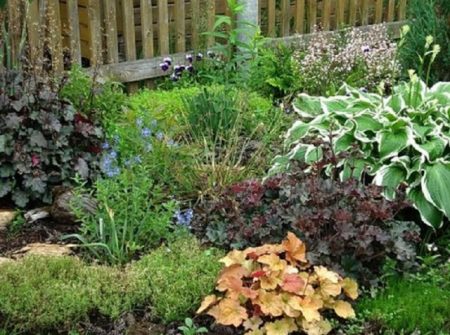
Surprisingly, the plant has a unique ability to harmoniously combine with absolutely all flowers and plants. The only thing that can sadden the gardener is the rapidly growing roots of heichera, who need a lot of space and nutrition. If you keep the culture next to trees or tall bushes, the heicher will not be able to compete with them for food, and therefore it will not develop well.
Heicher fits especially into the plain flower plantations, which have the same height as our princess. Her colorful crown will dilute the pallor of astilbe, bruners, Veronica, daylily, chrysanthemums. She can even get along with other shrub plants - hosts and ferns. It combines well with irises, geraniums and primrose.
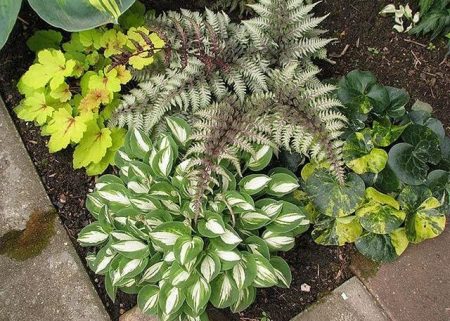
And, conversely, where there are too many flower colors, you can plant monochromatic varieties of heichera that moderate the ardor of a flower garden, which is about to turn into a scruffy, colorful flowerbed.
But the plant looks especially wonderful in the company of its own kind. A colorful ever-beautiful flower garden can be arranged from various varieties of heicher, picking up beautiful color combinations of leaves and flowers.
Wherever and with whomsoever you plant a heicher, it will always be in its place.
Choosing a landing place
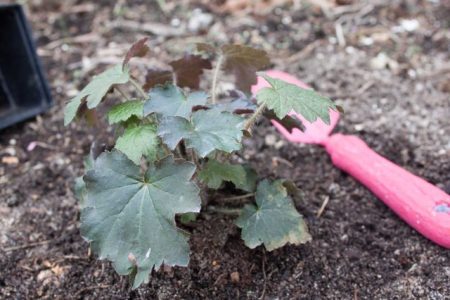
Geicher is not particularly demanding on growing conditions. But it should be borne in mind that in the sun it blooms better, and in the shade of its foliage gets more saturated colors. Therefore, choosing the place of planting of seedlings, it is important to determine the priority of what exactly you want to get from the plant - plentiful flowering or bright variegated foliage. It is ideal to plant heichera in the area where the sun shines before noon and partial shade appears after noon. Then the need for frequent watering will disappear.
The geography of the location of the culture must take into account the specific variety that will be cultivated.So, mountain geyhera are less demanding on the composition of the soil and the environment and temperature. They can grow even on sandstone, live in a multi-day drought. In this case, only the color of the leaves will change, but adverse climatic conditions will not affect the development of the plant. Forest species are recommended for cultivation on more fertile moist soils. On hot days, they need more water and shade. Red-leaved and bicolor varieties are best kept under the sun, and species with dark foliage are appropriate to grow in partial shade from other tall shrubs.

All species absolutely can not tolerate acidic soil and the accumulation of water at the roots. Therefore, if the land on the site does not fit the pH level, then it is preliminarily calcified and drained.
Types of Heicher
The pedigree of the plant is not too large and has about 400 species and varieties that differ in places of growth, height of bushes, texture and color of leaves, the shape of flowers, flowering time. All types of heicher are divided forest and mountain, as in Mexico and the mountainous regions of America they can be found in forests and woodlands. And in landscape design, only a tenth of all known varieties are used.
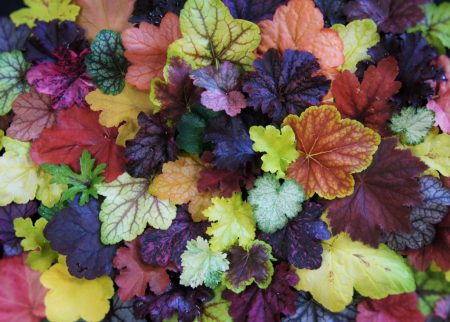
Geichers are divided into two types:
- Decorative foliage - plants with large variegated leaves.
- Ornamental-flowering - shrubs, the main decoration of which are flowers sprouting on long peduncles.
Heichera blood red Heuchera sanguinea
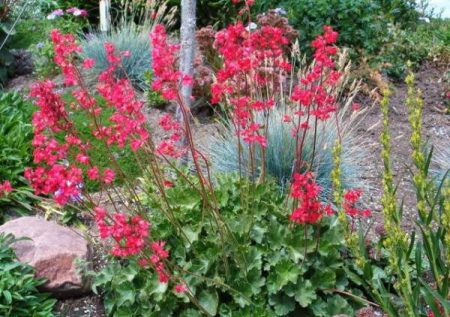
It was the blood-red heichera that became the basis for the creation of dozens of varieties used today in decorating the garden. Mountain view geyhera found in Mexico. Improved varieties have more powerful peduncles and branched inflorescences.
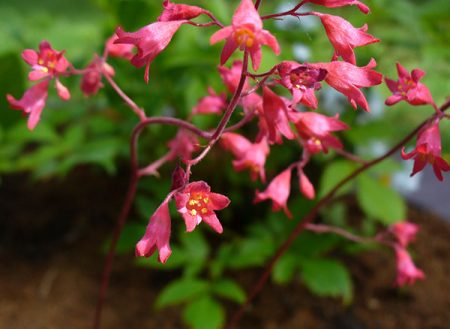
A distinctive feature of all varieties of blood-red geicher are hard, dense leaves of green color (less often you can find silver, cream, white shades of foliage). The shape of the leaf plates is round, with pointed edges. Red or raspberry small flowers collected in inflorescences-panicles give a special charm to the look. Separately, the flowers are similar in structure to bells. And it seems that the wind will blow and they will ring in all the districts.
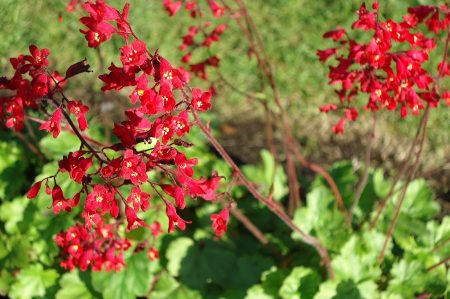
The blood-red heicher is also called the "coral bell."
A plant of this species belongs to stunted plants. The maximum height of the bush barely reaches 40 centimeters. It looks spectacularly how erect stalks protrude high from a thick green crown, the ends of which are hung with numerous flowers. Originally from the American foothills, the heicher has a powerful immunity to diseases and pests. She endures the cold and summer heat. It can grow unquestioningly in the shade, in a well-ventilated area. Even to the composition of the soil, it is unpretentious. The main thing is that the soil is well drained - the heichera does not tolerate strong moisture.
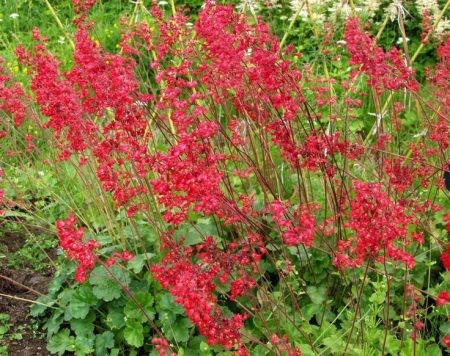
According to some reports, in ancient times, Indians used red heichera flowers to treat many diseases. It is believed that the mere presence of a plant in the house contributes to the healing of all family members.
This species is represented by such varieties: Alba, Mone, Robusta, Hercules, Splendens, Snowstorm, Variegata, Splish-Splash, as well as the varietal group Bressingham Hybrids.
Heichera American Heuchera americana
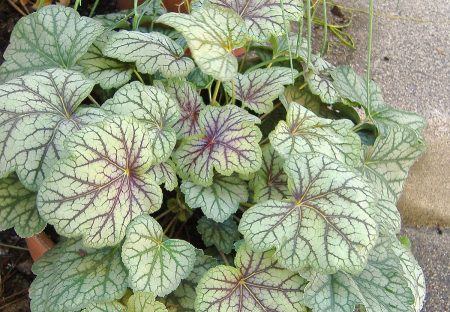
Another magnificent representative of the heicher family. In the wild, she lives in the foothills in the north of America. You can also meet her in undergrowths near ponds and lakes. The plant forms flowers mediocre: they are pale yellow, rare and unprepossessing. They bloom in early June and bloom almost until the end of summer, thinning the wondrous aroma throughout the district.
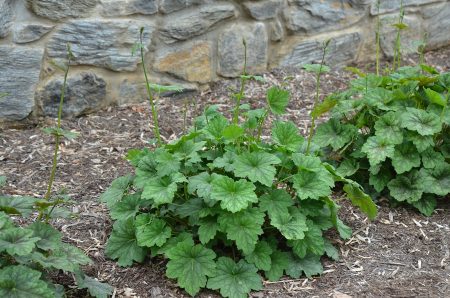
A completely different matter of foliage is the main advantage of an American. Long erect shoots adorn large toothed leaves with a rounded heart shape. The base of the leaf plate is green. The standard color is diluted with whitish stains and spots, purple streaks. The underside of the leaves is completely lilac.There are varieties with green leaves decorated with a red border.
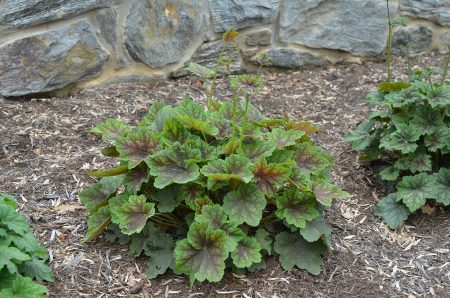
The most spectacular representative of this species is the variety Green Spice.
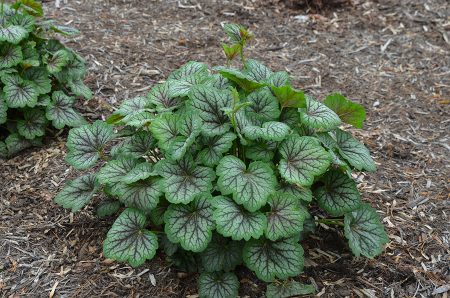
Heichera hairy Heuchera villosa
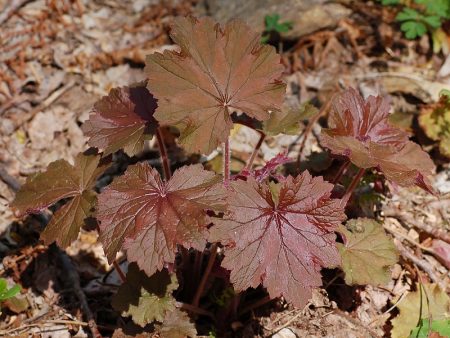
A view not often used in landscape design, but it still deserves the attention of decorators for its many advantages. The height of the hairy heicher reaches a limit of 45 centimeters. Large maple-shaped foliage, has a greenish-bronze color. Petioles are short, pubescent. Fleecy (hairy) peduncles rise high above the green crown, forming voluminous paniculate inflorescences, in which numerous pale-faced flowers of pale pink, greenish color are collected.
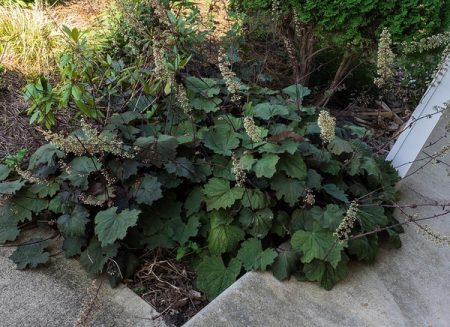
A striking variety of hairy heicher is the Bronze Wave variety. The plant is characterized by the beauty of its leaves: they are large, corrugated, have a small pile and are painted in bronze, coral, beige and orange. The bush blooms from June to August with delicate creamy flowers.
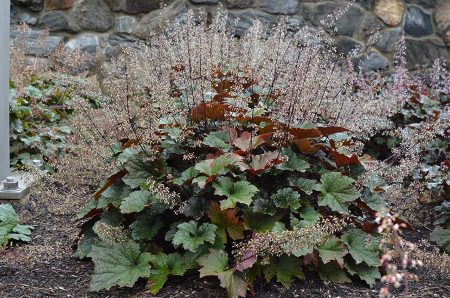
In the natural environment, hairy species can be found in the Mississippi River Valley.
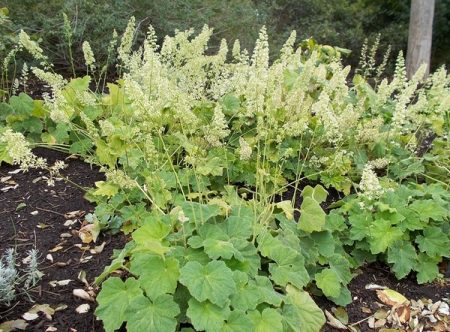
Hairy shrubs prefer moist, fertile soils and shaded areas. On the basis of such "unpretentious" data, scientists have created varieties suitable for cultivation on the territory of our country. True, they differ in the color of the foliage (more often it is purple, light green, apricot flowers), but keeping them in your garden is not difficult at all, since they almost do not require leaving.
Heicher cylindrical Heuchera cilindrica
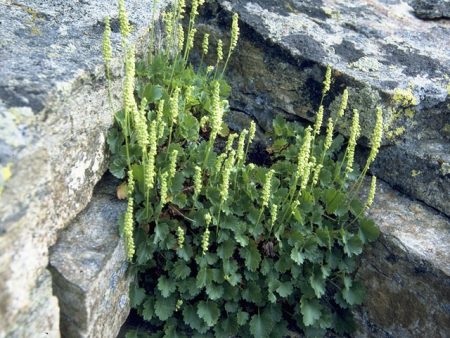
This name was given to the species mountain geyhera for high peduncles (up to 90 centimeters) and large flowers formed on long peduncles, which are collected in the likeness of cylinders. Inflorescences are dense, dense, there are a lot of them on the bush. The flowers sit on short stalks, have a different color of petals - from pink to yellow-green, depending on the variety. The leaves are rounded, in the form of a heart. Most often they are green with dark veins and silver tint.
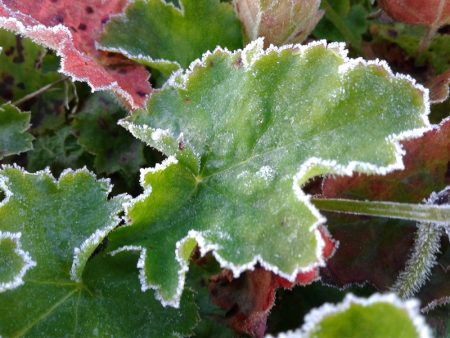
Cylindrical crops tend to loose light, fertile soils and medium light. The most popular varieties of cylindrical geyhera: Hyperion, Greenfinch.
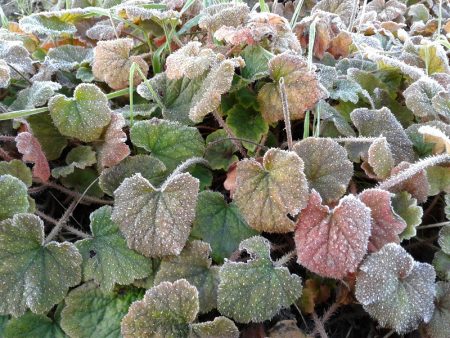
Heichera hybrid Heuchera hybrida
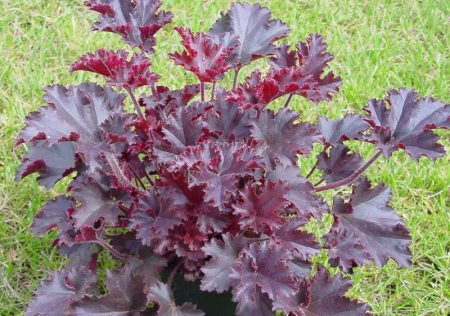
A variety of these heicher bred by multiple crosses of the American, small-flowered, hairy species. Thanks to their work, varieties with longer and more abundant flowering (up to 3 months) appeared. The plant forms a small bush 50-60 centimeters high. The leaves of hybrid varieties are larger, of any color (usually green) and textures, with and without patterns, embossed and simple, corrugated and semicircular.
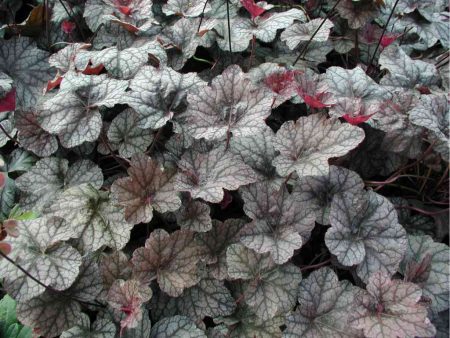
During flowering, small bell flowers of pinkish hues appear on the stems.
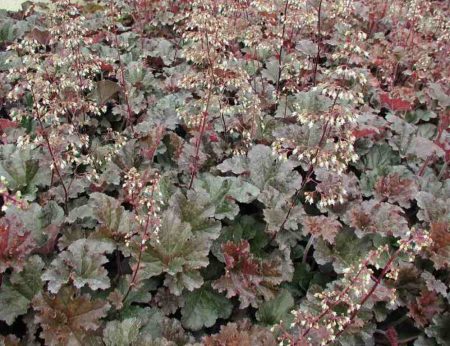
The type of hybrid heicher is called wagtail. The disadvantages of this variety include frequent shedding of inflorescences during wind. The best varieties: Cappuccino, Ruby, ValeKankan, Beauty Color. The most famous variety is Can-Can, which has won many exhibitions due to the presence of corrugated burgundy leaves with silver spots.
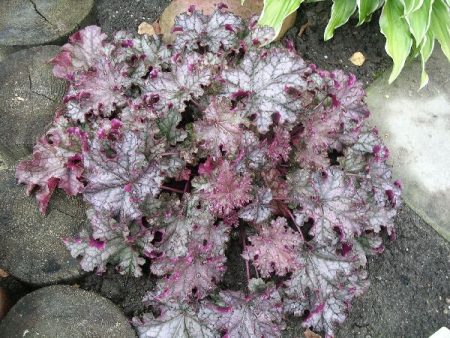
Heichera gooseberry leaf Heuchera grossulariifolia
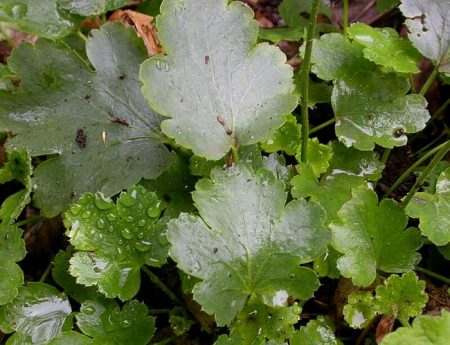
Very popular variety in Russia. Low-growing bushes are overgrown with small wedge-shaped leaves up to 7-8 centimeters in diameter, from the thick of which long 30-40 centimeter peduncles rush up. Their ends in mid-summer are decorated with small inflorescences of large white flowers.
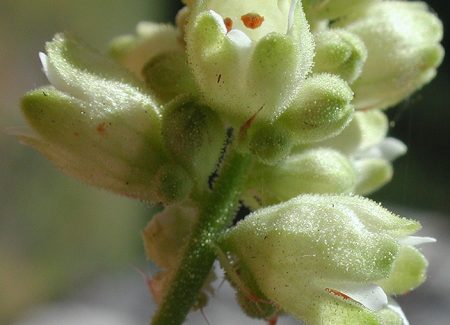
All varieties of gooseberry leaf geyher have amazing winter hardiness, strong immunity to diseases. For these qualities, Russian gardeners who live in the middle lane of the country love to plant it.
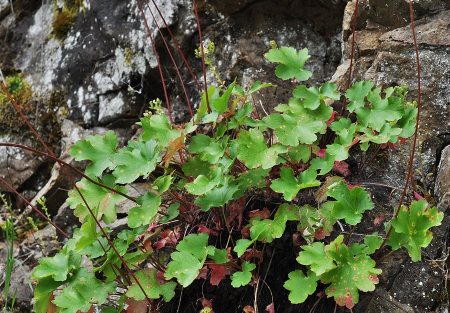
Heichera small-flowered Heuchera micrantha
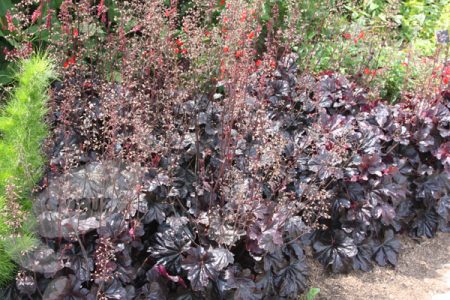
A variety of plants is considered the most spectacular among the culture.Maple small leaves have a very different color, which makes the bush variegated, playful. Some varieties are painted in bronze, others in purple, and others can be cast in silver. The flowers as well as the leaves are small, velvet. Usually they are creamy, pink in color with orange anthers. Plants grow well on moistened organic soil.
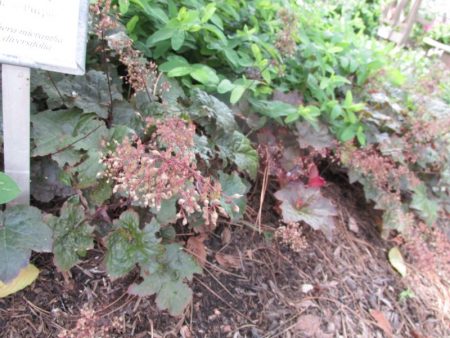
Palace Purple is recognized as a popular variety of small-flowered geyhera. The plant is not capricious, winter-hardy. It grows well on slightly acidic soil.

Palace Purple in the 90s was reputed to be the most popular perennial among ornamental plants.
Caramel
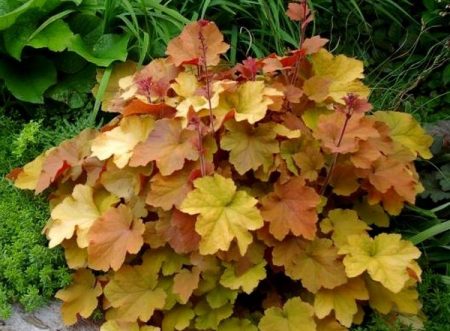
This geicher variety got such a “sweet” name due to the caramel color of the foliage and its voluminous texture, which, it seems, can be bitten off and it will turn out to be sweet in taste.
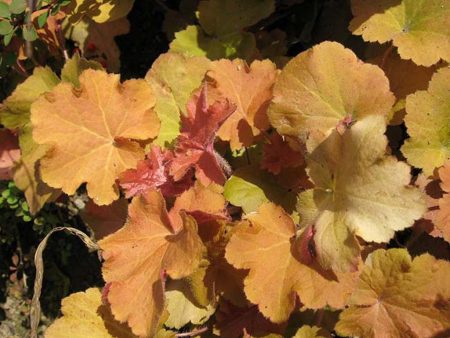
Caramel is a very common varietal plant. It is popular because of openwork carved leaves painted red at a young age, and when they mature, they acquire golden, amber tones. Redness remains only on the underside of the leaf plate. During flowering, small cream-colored flowers appear on the peduncles.
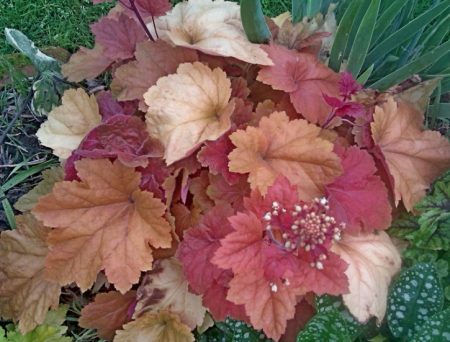
The bush grows and develops very quickly, it is capable of growing a thick dense crown in one summer, which looks especially beautiful in the flower garden after rain, when the foliage is strewn with shiny drops of water, similar to melted sugar. Caramel geyhera is not afraid of cold weather. The variety is readily used by garden decorators to create colorful, diverse textures.
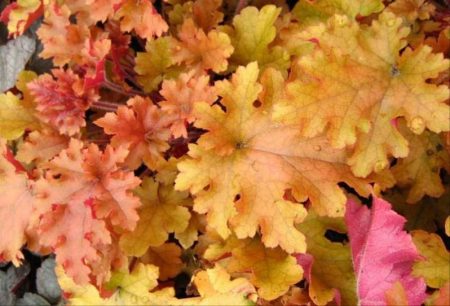
Marmalade
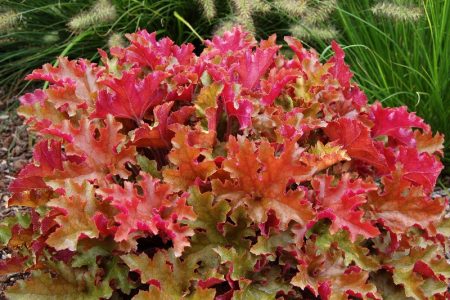
In summer, the bush is similar to autumn, that is, the foliage is painted in yellow-green tones, as if the plant is preparing to remove old foliage. This combination of colors gives the garden a romance and melancholy.
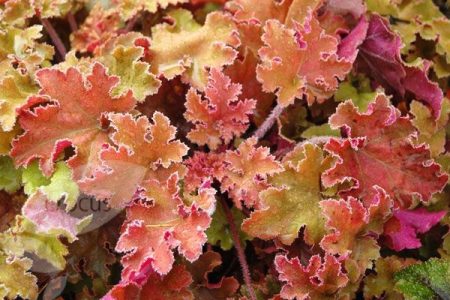
By the end of summer, the foliage gradually turns into a fire hat, the top of which is decorated with numerous small mediocre pale pink inflorescences. The plant blooms in early summer.
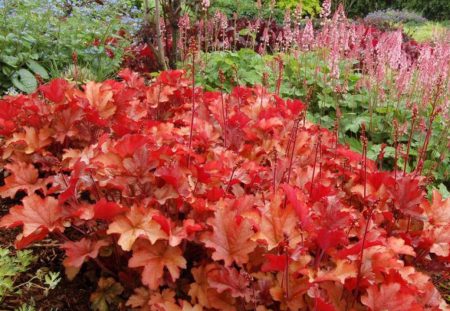
Foliage changes color from spring to autumn, and all this time remains very decorative.
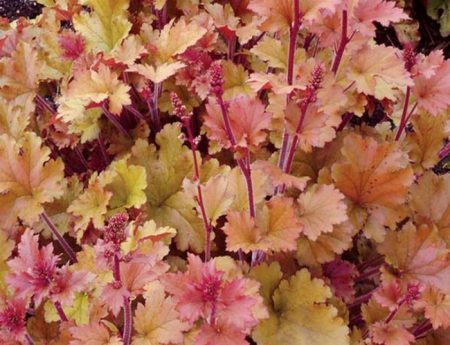
Geicher Cherry Cola
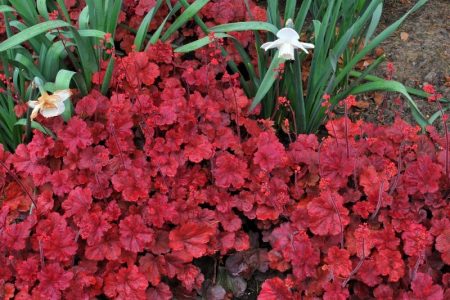
An incredibly gentle undersized plant that can be planted along the bottom row of the flower garden, along curbs or grown in hanging flower pots. The height of the bush hardly reaches 20 centimeters. The plant grows very slowly, smoothly, without rushing anywhere, and urging you to admire its graceful forms as long as possible. The variety is characterized by rounded wavy foliage, which with age changes its matte color from orange or red to yellow or green gloss. Along the entire length of the brown peduncles are red or "salmon" inflorescences.
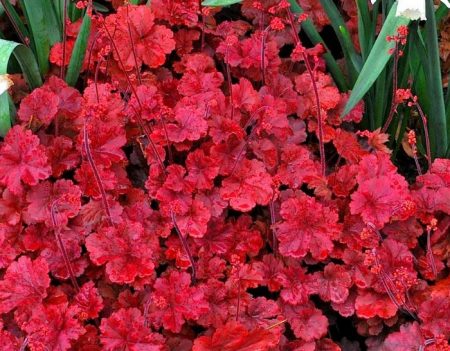
Due to its small stature, a wrongly located Cherry geicher in the flowerbed may get lost. Think about it while creating a floral arrangement.
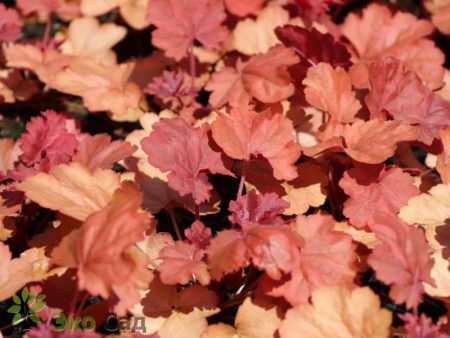
Purple castle
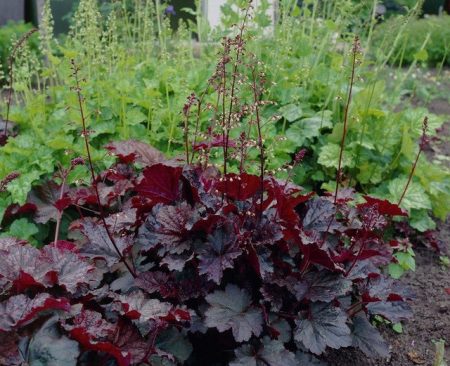
The variety belongs to the group of small-flowered geicher. Bred in 1980. The structure is similar to ivy. Plants of this species have the ability to multiply rapidly due to the large number of branched rhizomes. Due to this feature, they like to use the purple castle in border compositions and plant along the paths.
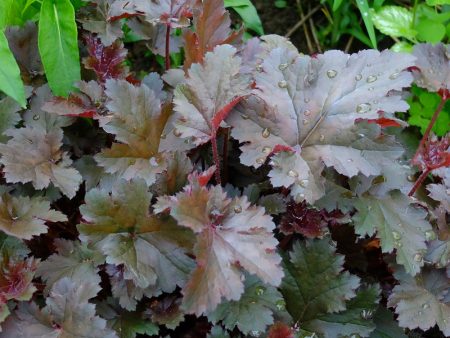
Textured bushes in rock gardens look wonderful. Many small buds are collected in a panicle inflorescence. Basically they are painted in beige color, which combines atmospheric with purple leaves. The originality of the color of the foliage (purple, burgundy, violet) makes the heicher indispensable in any flower bed. Plants, by their presence, are designed to slightly dim the brightness of paints of other colors. Purple Castle looks good in solitary landings or in combination with other plants, such as geranium, hosta.
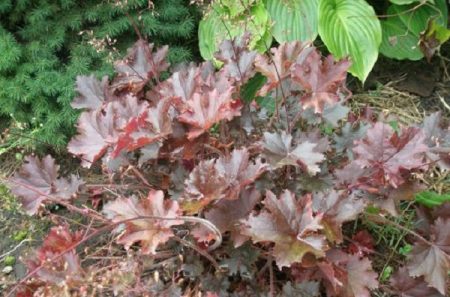
Black bird
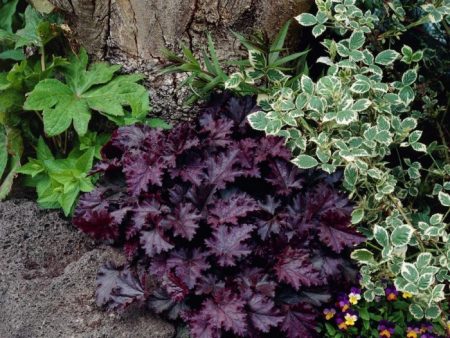
Very effective variety. The crown of the bush grows 50-60 centimeters tall. Long stiff peduncles rise above it another 20-30 centimeters higher. The foliage is stiff, rough, pentagonal. The real highlight of the variety is its color - it is dark burgundy, almost black.For the similarity of large dark leaves with the wing of a raven, the variety was named. Dilute the "blackness" voluminous loose cream-colored inflorescences.
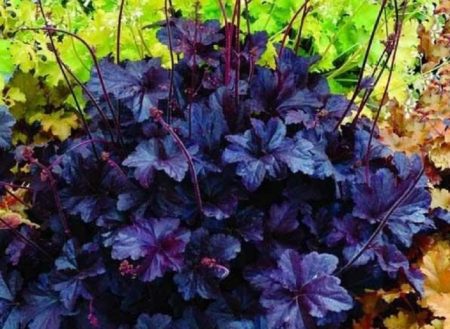
Black Bird Plants are ideal for growing along paths.
Conclusion
A colorful and always different heicher will inevitably become a favorite of any garden, park, terrace. Whatever variety you choose, this plant is ideal for your home, fill it with a pleasant honey aroma and enrich the area with a riot of colors. In landscape design there is no longer such a flower culture that can surprise with so many colors and unusual shapes of leaves.

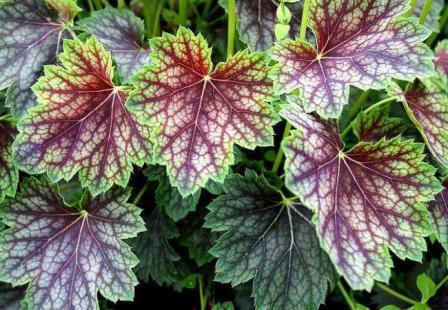
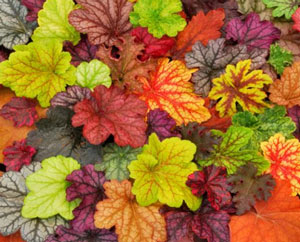
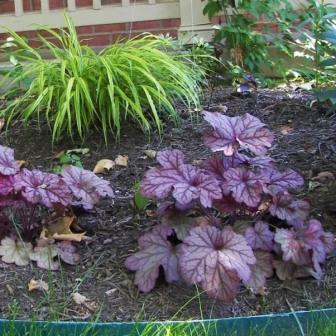 Geicher: varieties and species, photo titled
Geicher: varieties and species, photo titled